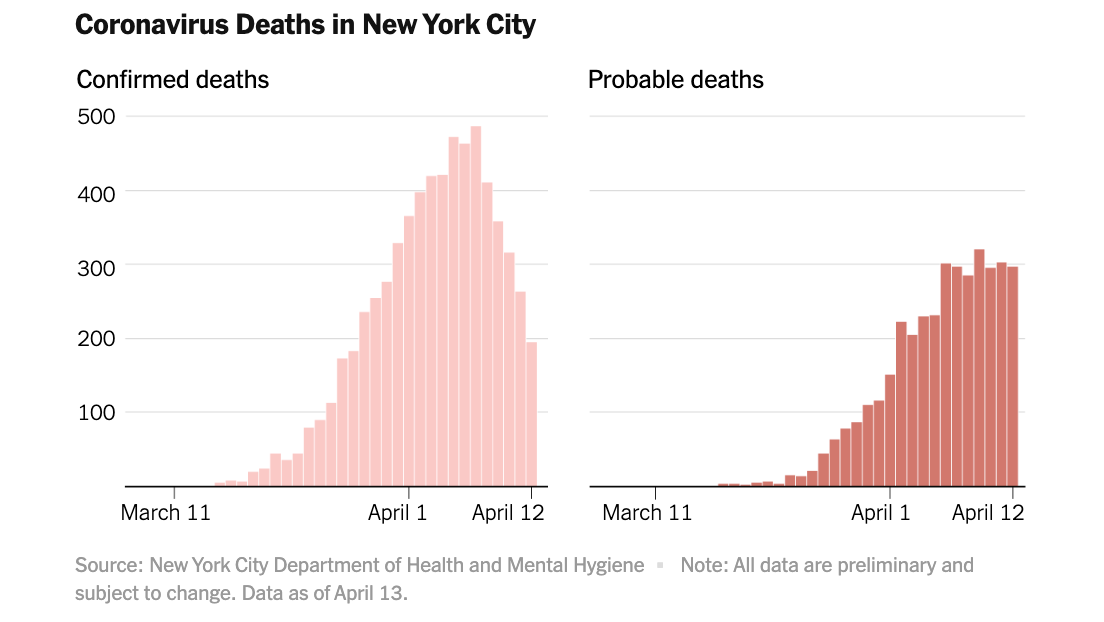COVID-19 day 86 : 📈 639,628 cases; 30,985 deaths : 15 April 2020
Day-to-day death numbers doubled in the US, as NYC adds presumed positive cases to the total; protesters want to open the economy in MI and OH; Afghan girls robotics team in the news

It’s day 86 since the first case of coronavirus disease was announced in the United States. Tonight’s issue: time and resilience.
I think people haven’t understood that this isn’t about the next couple of weeks. This is about the next two years. ~ Michael Osterholm, an infectious-disease epidemiologist at the University of Minnesota, in The Atlantic
What feels like a year ago, but was probably early March, I asked on Facebook how we could shift focus from death stats to the journey ahead of those who were recovering (and that lingering impact on the health care system). We still haven’t made that shift, so making this transition - to thinking about 2022 - is going to be a very hard sell. Doubt me? See Michigan and Ohio, Wednesday.

In Our Pandemic Summer (The Atlantic, 15 April 2020), Ed Yong writes:
The pandemic is not a hurricane or a wildfire. It is not comparable to Pearl Harbor or 9/11. Such disasters are confined in time and space. The SARS-CoV-2 virus will linger through the year and across the world. “Everyone wants to know when this will end,” said Devi Sridhar, a public-health expert at the University of Edinburgh. “That’s not the right question. The right question is: How do we continue?” (emphasis added)
This is a long read. Go print it now (18 pages), so you can read it slowly. (Research shows we skim more/faster on the screen which affects comprehension.)
One more teaser:
If it turns out that, say, 20 percent of the U.S. has been infected, that would mean the coronavirus is more transmissible but less deadly than scientists think. It would also mean that a reasonable proportion of the country has some immunity... However, if just 1 to 5 percent of the population has been infected—the range that many researchers think is likelier—that would mean “this is a truly devastating virus, and we have built up no real population immunity,” said Michael Mina, an epidemiologist and immunologist at Harvard. “Then we’re in dire straits in terms of how to move forward.”
Wednesday, Johns Hopkins reported 639,628 (609,422) cases and 30,985 (26,056) deaths in the US, an increase of 4.96% and 18.92%, respectively, since Tuesday.
That case rate is 193.24 per 100,000; the death rate is 93.61 per million.
One week ago, the case rate was 130.55 per 100,000; the death rate is 44.74 per million.
🤓Recommended reading
We know that COVID-19 harms our lungs. And that people with pre-existing conditions are more vulnerable. But doctors believe that problems with other organs is happening too frequently to be solely from a “‘cytokine storm,’ a powerful immune-system response that attacks the body, causing severe damage, doctors and researchers said.” About half of those hospitalized have “blood or protein in their urine, indicating early damage to their kidneys.” Another “14 to 30 percent of intensive-care patients in New York and Wuhan, China” have lost kidney function and must have dialysis.
Coronavirus destroys lungs. But doctors are finding its damage in kidneys, hearts and elsewhere. Washington Post, 15 April.
🔬Research and medical news
[P]rescriptions for medicines needed for Covid-19 patients who are placed on ventilators are being filled and shipped to hospitals only 53% of the time, down from 72% last month, according to new data.
As demand surges, half of prescriptions needed for Covid-19 patients on ventilators are going unfilled. STAT News, 15 April 2020.
💃🏼Life hack


⓵ Around the country
All 50 states, the District of Columbia, Guam, the Northern Mariana Islands, Puerto Rico and the US Virgin Islands have identified COVID-19 cases and all have at least one death.
On a per capita basis, this is the death rate in the top five states (per million):
New York, 595.57
New Jersey, 355.32
Connecticut, 243.46
Louisiana, 237.27
Michigan, 192.35
US average, 93.61

There was an alarming increase in the number of daily deaths reported today. The number of deaths more than doubled, from 2,435 on Tuesday to 4,929 on Wednesday. The reason?
New York City is now including presumed-positive deaths in its COVID-19 statistics. “Far more people have died in New York City, on a per-capita basis, than in Italy — the hardest-hit country in Europe.” This change in reporting does not include collateral deaths - people who were afraid to go to the doctor or ER, for example.


South Dakota: The first employee of the Smithfield Foods plant to die from COVID-19 infection. He was a 20-year employee and had continued working even as he had initial symptoms. There are now 644 confirmed cases linked to the Smithfield pork plant.
⓶ Around the world
The number of affected countries/territories/areas jumped from 29 at the end of February to 208 today. Although early reports tied the outbreak to a seafood (“wet”) market in Wuhan, China, analyses of genomic data suggest that the virus may have developed elsewhere.
This infographic is from London and uses a different dataset from Johns Hopkins.

Afghanistan: You’ve heard of the Afghan Dreamers, a girls robotics team denied entry to the first global robotics competition in the US in 2017. The robotics team is making news again: they have developed an inexpensive ventilator based on parts from a Toyota Corolla and a design from MIT. Their goal is for the prototype to be approved by the World Health Organization and the Afghan Public Health Ministry. Why a ventilator? On 02 April, the two hospitals designated for coronavirus cases had only 12 working ventilators between them.
Brazil: On 06 April, Brazil was 15th in the total cases list with 12,232 official cases. Today, it had jumped to 11th, with 28,912. It’s a large country, 212 million, so its case rate is still relatively low. But research from the universities of Sao Paulo and Brasilia suggests that the infection rate is 13 times greater than the official data. “The Latin American country hardest hit by the pandemic, Brazil is registering a higher percentage of people cured of Covid-19 than carriers.”
Russia: The virus has been detected across the country, except for Siberia.
New Zealand: Prime Minister Jacinda Ardern announced that she and her cabinet ministers would be taking a 20% pay cut for the next six months. An additional 20 people were diagnosed with COVID-19 overnight, bringing the total to 1,401.
⓷ Politics, economics and COVID-19
Health care workers are bearing the brunt of this disease: they are 20% of those who test positive. And their viral load is much higher than the average person.
Back in Wuhan, Li Wenliang, a 33-year-old ophthalmologist, was one, if not the first, doctor to alert people in China of the outbreak. He died on February 7, 2020. But he certainly wasn’t the youngest doctor to die in China. Xia Sisi, a 29-year-old gastroenterologist, also died after a 35-day hospitalization.
Yet on March 11, from the Oval Office, President Trump stated, “Young and healthy people can expect to recover fully and quickly.”

The IRS website may be having issues (this is my screen capture at 11 pm Pacific). If you have questions about CARES Act checks, USA Today may have an answer. Like many people, we tried to access the Get My Payment portal only to be told “Payment Status Not Available.” The error message above came when trying to access our IRS account. Some people are reporting that their checks appear to have been deposited to a bank other than their own.
⓸ Case count
There is a lag between being contagious and showing symptoms, between having a test and getting its results. The virus was not created in a lab.
🌎 15 April
Globally: 1 914 916 confirmed (70 082 - new) with 123 010 deaths (5989 - new)
The Americas: 673 361 confirmed (28 404- new) with 27 336 deaths (1785- new)
Johns Hopkins interactive dashboard (11.30 pm Pacific)
Global confirmed: 2,064,668 (1,982,552)
Total deaths: 137,078 (126,753)
🇺🇸 15 April
CDC: 605,390 (579,005) cases and 24,582 (22,252) deaths
Johns Hopkins*: 639,628 (609,422) cases and 30,985 (26,056) deaths
State data*: 633,775 (604,147) identified cases and 28,276 (25,829) deaths
Total tested (US, Johns Hopkins): 3,261,611 (2,964,726)
View infographic and data online: total cases, cases/100,000 and deaths/million.
* Johns Hopkins data, ~11.30 pm Pacific.
State data include DC, Guam, the Northern Mariana Islands, Puerto Rico and the US Virgin Islands
See US (state/territory) total cases, cases/100,000 and deaths/million as infographics.

⓹ What you can do
Stay home as much as possible, period.
Digestive problems may be a symptom.
Resources
👓 See COVID-19 resource collection at WiredPen.
📝 Subscribe to Kathy’s Daily Memo :: Daily Memo archives
🦠 COVID-19 @ WiredPen.com
🌐Global news
// CIDRAP / STAT News // BBC / Financial Times / Global China Daily / New Straits Times / South China Morning Post / The Age / The Globe and Mail / The Guardian // New York Times / Seattle Times / Wall Street Journal / Washington Post // The Atlantic / The Conversation / The Economist / ProPublica // ABC News (Australia) / BBC News / BBC News China / CBC (Canada) // ABC News (US) / CBS News / CNBC / CNN / C-SPAN / NBC News //



